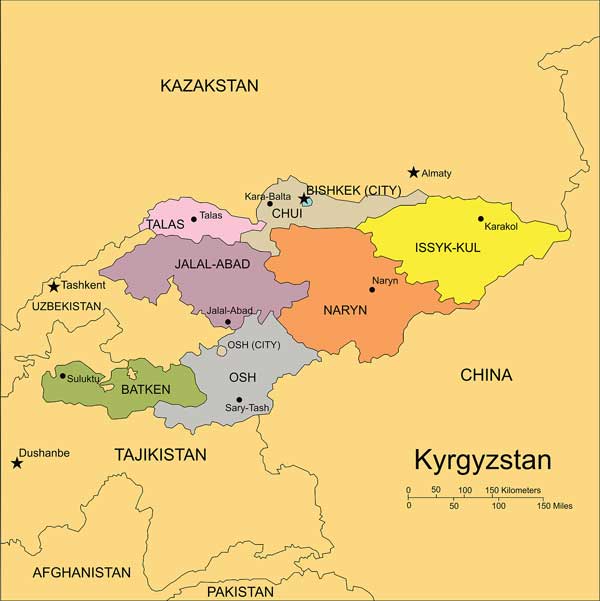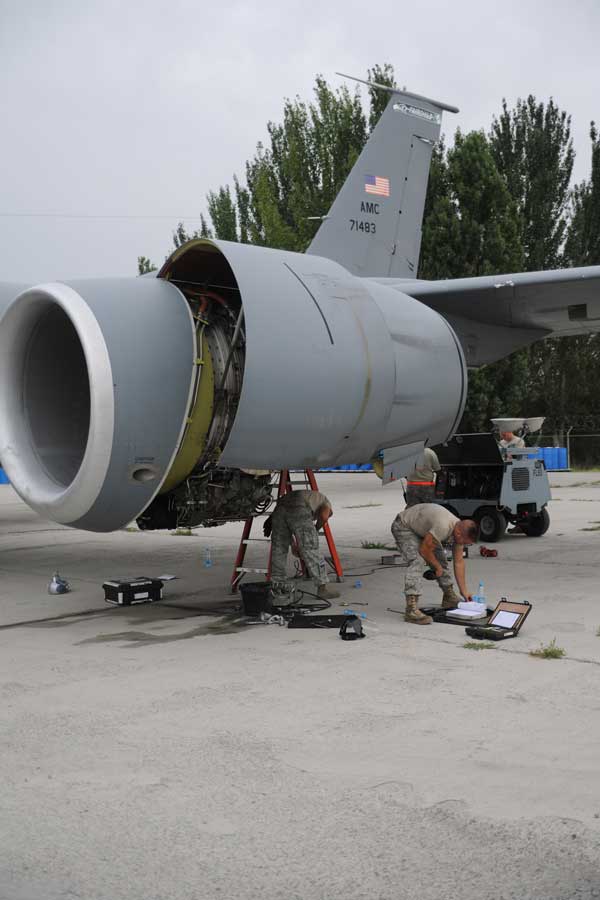11/16/2011 – by Dr. Richard Weitz
Despite the inevitable charges of electoral fraud, Kyrgyzstan’s presidential election seems to have gone reasonably well. An end to Kyrgyzstan’s political instability would be good for the entire region. The earlier political violence in that country threatened U.S. and Russian military installations as well as the main conduit by which American troops enter and leave Afghanistan.
Although impoverished and isolated Kyrgyzstan is not sufficiently important to Russia, China, the United States or other great powers as to lead to a major clash among them, they each have important interests at stake in seeing a stable Kyrgyzstan.
Chinese officials fear that continued instability in their western neighbor will spill over into China or other Central Asian states, complicating Beijing’s efforts to exploit the region’s natural resources.
 The logistical neighborhood to support Afghan operations. (Credit Image: Bigstock)
The logistical neighborhood to support Afghan operations. (Credit Image: Bigstock)
Russian policy makers seem most concerned about how instability in Kyrgyzstan makes Moscow and its regional security institutions look impotent. The surprising failure of either the Shanghai Security Organization (SCO) of the Collective Security Treaty Organization (CSTO) to assist the Kyrgyz government to suppress the June 2010 riots sparked concerns by many Central Asians over whether they can rely on the these institutions to defend them against domestic security threats. Another Russian concern is how the collapse of Kyrgyz border controls are facilitating drug trafficking and other transnational crimes in Central Asia, which can easily spill over into the Russian Federation due to the weak border controls separating these former Soviet republics.
U.S. officials have long been concerned about Kyrgyzstan given the vulnerability of the international coalition’s supply lines into Afghanistan.
Allied military planners have always had to worry about their ability to support their very sophisticated and very high-maintenance force in such a distant, land-locked and logistically challenging theater of operations as Afghanistan. The recent surge in the number of U.S. combat troops has only aggravated that problem by requiring the United States to increase considerably its deliveries of food, fuel, munitions, and construction materials to this remote, mountainous, and landlocked country.
The United States and NATO opened the so-called Northern Distribution Network (NDN) in 2008 to provide another supply route to Afghanistan. The NDN, which is also used for non-lethal supplies and equipment, connects Baltic and Caspian ports with Afghanistan via Russia, Central Asia, and the Caucasus. NATO transit to Afghanistan goes through the NDN, either through Russia, Kazakhstan, Tajikistan, and Uzbekistan, or alternately through the South Caucasus and the Caspian Sea.
This 5,000 kilometer transportation network (a distance five times longer than the 1,000-kilometer journey from Karachi to Kabul) involves the delivery of supplies to European ports, where they are loaded onto railway carriages or airplanes and sent through Russia to Kazakhstan or Uzbekistan. From there, the cargo is placed on trucks or trains for shipment into Afghanistan.
Although critics might argue that all the West has done was increase its reliance on vulnerable supply routes, the net effect has been to reduce NATO’s overall vulnerability to supply cutoffs.
Having a portfolio of roots means that, if one communications line is interrupted, the allies still have others to count on. Perhaps the one drawback of the NDN is that, although it has both reflected and contributed to improved relations between the United States and some of the former Soviet republics such as Russia and Uzbekistan, U.S. officials have had to reduce its pressure on these typically authoritarian regimes to liberalize their political systems or respect their citizens’ human rights.
This development does leave the United States vulnerable to further regime changes in the region, such as the one that occurred in Kyrgyzstan in 2010,which partly resulted from U.S. diplomats overlooking corruption and other criminal government behavior in order to not jeopardize U.S. access to the Manas air base there.

Kyrgyzstan is not a major player in the NDN, but its Manas international airport has played an important role in providing a means by which NATO soldiers can enter and leave Afghanistan. Since Uzbekistan evicted American military personnel from its territory in 2005, Manas has been the main U.S. military transit facility in the region.
The Pentagon has used the base to support U.S. military operations in Afghanistan since late 2001.Almost all American soldiers who deploy on the ground in Afghanistan enter and leave through Manas. The international airport’s two main assets are its relatively advanced facilities and its pivotal location. Its 4,200-meter runway, shared between the military and civilian airports, was originally constructed for Soviet bombers and has proved uniquely capable among Kyrgyzstan’s airports of sustaining round-the-clock support for large military aircraft such as cargo and tanker planes. Their crews can make the 1,000-mile flight to Afghanistan in 90 minutes, many hours less than any other major airport.
Nonetheless, the United States and other NATO countries lack sufficient strategic airlift or funding to supply their forces in Afghanistan by air. Although globally only some 10 percent of all U.S. military supplies are moved by air, the shipment of goods to Afghanistan by military or civilian cargo planes is already approximately 30 percent. It also costs about $3 per pound to ship goods by air to Afghanistan, compared with 30 cents for surface delivery.
For this reason, only the most important items are sent by air to Afghanistan, such as weapons, ammunition, critical equipment, and U.S. soldiers, who enter and leave Afghanistan via Manas airbase in Kyrgyzstan. The rest of NATO’s cargo reaches Afghanistan through Pakistan and, increasingly through the NDN. (See further: https://www.sldinfo.com/general-mcnabb-on-meeting-the-challenge-in-afghanistan/)
The Central Asian countries have been logical partners to support a U.S.-led NATO surge in Afghanistan. Tajikistan, Turkmenistan, and Uzbekistan border Afghanistan, while Kyrgyzstan and Kazakhstan are located nearby. Their governments share Western concerns that renewed Taliban control over parts of Afghanistan would give an impetus to Islamist militancy in the region. All Central Asian regimes have been targeted to various degrees by Muslim extremist organizations linked to the Taliban and al-Qaeda. Most recently, Tajikistan has seen a revival of the Islamic Movement of Uzbekistan, the region’s main Islamist terrorist network before U.S. forces destroyed the Movement’s bases in Afghanistan in late 2001.
Central Asian governments would generally like to curb the flow of narcotics from Afghanistan to and through their countries. Although some Central Asian groups profit from the regional drug trade, many societies suffer from the associated increase in crime, corruption, and local narcotics use. Narcotics traffickers are rumored to have helped finance some of the mass violence that plagued Kyrgyzstan last year as a means of disrupting national law enforcement operations.
Central Asian leaders are also eager to maintain NATO’s presence in Eurasia to help balance Russia and China, whose military and economic predominance raises the risk of a Sino-Russian condominium at their expense. Although regional leaders generally enjoy good ties with Moscow and Beijing, they fear that Russian military and Chinese economic dominance raises the risk of a Sino-Russian condominium at their expense.
Commercial considerations also drive their interest in supporting the operation: the recent economic crisis in the region, worsened by the collapse in world oil prices, makes their governments interested in the jobs, service payments, infrastructure improvements, and other economic contributions the transshipments could provide. Central Asian leaders can also solicit bribes to enrich themselves are well as pay off political supporters.
Yet, one must not exaggerate the probable impact of the NDN on relations with Russia or the Central Asian states. These authoritarian regimes will inevitably channel foreign economic and military activities so that they strengthen their regimes. The Western companies and other foreign contractors have not helped strengthen the rule of law in commerce or promoted liberalization of their economies. Rather, those foreign contractors the Pentagon and other NATO militaries use to convey their goods to Afghanistan through Eurasia accept they sometimes must pay bribes and undertake other dishonest behavior to keep their business.
When foreign activities threaten to undermine these regimes and networks, they are resisted. The most notable case occurred in July 2005, when Uzbek President Islam Karimov concluded that U.S. promotion of democratic revolutions and human rights in his region threatened his authority. He therefore expelled the U.S. military from what had been its most important base at the time at Karshi-Khanabad. The Pentagon almost lost access to Manas Air Force Base in 2009 when it looked as if Washington would not match the bids Moscow and Beijing were reportedly offering for an end to the U.S. lease there. Fortunately the Kyrgyz President, since deposed, was open to soliciting multiple payments from multiple parties in the gamble that none of the parties would become so irritated as to break relations with him entirely.
Currently the main worries again center on Uzbekistan, which has emerged as the most important transshipment country along the NDN, since its good railway lines traverse the country’s territory and also bridge the Amu Darya River to reach the Afghan village of Hairaton From there, goods are conveyed by truck to the rest of Afghanistan. In a congressional hearing last November, David Sedney, deputy assistant secretary of defense for Afghanistan, Pakistan and Central Asia, said that about 98 percent of all NDN shipments pass through Uzbekistan. It is no accident that Secretary of State Hillary Clinton visited Uzbekistan again during her trip last week to the region.
Although the Uzbek government has managed to suppress local terrorism, the regime will be extremely vulnerable when Karimov dies or otherwise leaves office, since the political succession process will lack preparation and probably legitimacy. Meanwhile, Karimov will prove a difficult international partner. He seeks to balance between Russia and the West while remaining strongly independent of both.
Uzbekistan may also prove less interested than other NDN states in the economic benefits from servicing the northern supply route to Afghanistan.
The country has a strong overall growth rates and double-digit growth in its industrial sector. Uzbek officials have kept their annual budget deficits and overall public debt relatively small. Uzbeks have been able to leverage their natural endowments with late-comer advantages. Another reason for Uzbekistan’s strong performance has been its growing economic ties with China, which is paying top dollar for Central Asian oil and gas. PRC investors are financing region-wide infrastructure improvements in energy production and transportation. For Uzbekistan to graduate from lower-middle income status to become a high-end middle income economy, they need to improve its infrastructure, education, and macroeconomic environments as well as expand business transparency. Participating in the NDN can contribute marginally if at all to realizing these goals.
Fortunately, Karimov is eager to restore relations with the West at the moment, and is one of the few Central Asian leaders sufficiently concerned about Afghanistan to offer his own peace plan. Washington and the other NATO governments might as well take advantage of the current mood in Tashkent to try to shore up the region’s defenses before U.S. leverage declines along with the withdrawal of U.S. military forces in coming years.

